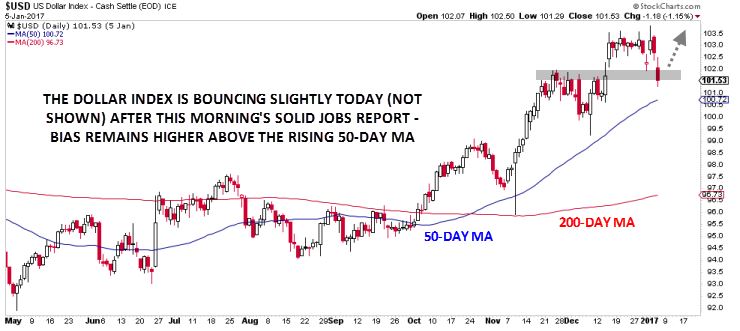If you follow financial media, you've probably noticed that pundits have a tendency to dub every monthly NFP release as "THE MOST IMPORTANT JOBS REPORT OF ALL TIME!"
At least in terms of its impact on Fed policy, even the most ardent headline grabber would have trouble spinning Friday's release as particularly significant. That said, the report was fairly important from a sentiment perspective: after weak readings in the ADP report, employment component of the ISM Non-Manufacturing PMI index and Challenger job cuts, the so-called "Trump Trade" of rising US yields and US dollar was on the ropes.
Friday's reading certainly did a bit to assuage dollar bears' darkest concerns. While the headline jobs figure came in at just 156k (vs. 175k expected), the details of the report were far better. Straight away, the previous two jobs reports were revised up by about 30k jobs, meaning that overall employment actually beat the anticipated number slightly. More importantly, traders learned that average hourly earnings rose 0.4% month-over-month, or 2.9% on a year-over-year basis -- which represents the highest rate of wage growth since 2009. In other news, the unemployment rate ticked up to 4.7% as expected, while the average-hours-worked figure held steady at 34.3 hours per week.
Mid-way through Friday's trade, USD was marginally higher on the day to 101.85, roughly retracing Thursday's losses. However, the index remains well off Tuesday's high near 104.00, begging the question: Is the strong-dollar "Trump Trade" running out of steam or just taking a breather before the next rally to new highs?
These types of questions are notoriously hard to answer definitively -- if they weren't, we'd all be billionaires -- but from a trend perspective, the dollar's rising tide remains intact. Looking at the medium-term chart below, the US dollar index remains above both its rising 50- and 200-day moving averages. The most recent pullback has merely taken the index back to the late-November highs, which now appear to be providing a bit of support.

Source: Stockcharts.com
That said, if the dollar index sells off to trade back below its 50-day (~100.75) early next week, it would shift the near-term bias back to neutral. For now, though, we're inclined to give the established uptrend the benefit of the doubt, especially with the tailwind of Friday's solid-if-not-spectacular jobs report.
